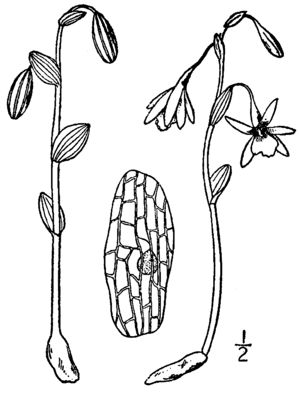- Triphora
-
Triphora 
Triphora trianthophora – Zeichnung aus:
N.L.Britton & A.Brown:
Illustrated flora of the northern states and Canada
Vol. 1: Tafel 562 (1913)Systematik Monokotyledonen Ordnung: Spargelartige (Asparagales) Familie: Orchideen (Orchidaceae) Unterfamilie: Epidendroideae Tribus: Triphoreae Gattung: Triphora Wissenschaftlicher Name Triphora Nutt. Die Gattung Triphora aus der Familie der Orchideen (Orchidaceae) besteht aus 18 Arten. Sie kommen hauptsächlich im tropischen Amerika vor, eine Art auch im östlichen Nordamerika.
Inhaltsverzeichnis
Beschreibung
Die Triphora-Arten sind krautige Pflanzen, sie betreiben Photosynthese oder ernähren sich mykoheterotroph.[1] Ein Rhizom fehlt oder ist nur sehr kurz. Ein oder mehrere Wurzeln sind fleischig und knollig verdickt.[2] An der Basis des Sprosses befinden sich faserige Wurzeln, die in einiger Entfernung Knöllchen bilden können.[3] Der Spross ist schlank und trägt wenige, am Spross verteilte Blätter.[2] Die Blätter sind zweizeilig angeordnet, die Blattspreite ist lanzettlich bis oval, der Blattgrund umfasst den Spross. Häufig sind die Blätter stark reduziert,[3] die Blattfarbe ist ein rötliches Grün. Die Blätter sind längs mehrerer Blattadern gefältelt (plikat) oder glatt und in der Knospe gerollt (convolut). Der Blattrand ist glatt oder leicht gesägt.[4]
Die Exemplare einer Population blühen oft genau gleichzeitig. Die einzelne Blüte hält nur einen Tage, die Blüten eines Blütenstands blühen nacheinander auf.[4] Der Blütenstand enthält ein bis zehn Blüten, die – je nach Art – resupiniert sind oder nicht. Die Tragblätter gleichen den obersten Laubblättern. Der Fruchtknoten ist schmal spindelförmig.[3] Die Blütenblätter sind nicht miteinander verwachsen, sie sind weiß bis rosa gefärbt. Die Sepalen und seitlichen Petalen sind einander ähnlich, lanzettlich geformt.[4] Das dorsale Sepal ist konkav bis kapuzenförmig gebogen, die seitlichen Sepalen sind asymmetrisch und leicht sichelförmig gebogen. Die Lippe ist an der Basis keilförmig verschmälert, die Spreite ist dreilappig.[2] Auf der Spreite befinden sich drei längs verlaufende, gelb oder rosa gefärbte Leisten. Die Säule ist weiß oder hellgrün,[4] gerade und leicht keulenförmig.[4] Die Narbe ist einfach oder zweilappig. Das Staubblatt enthält zwei Pollinien, die von mehliger Konsistenz sind. Die Kapselfrucht ist oval bis umgekehrt-eiförmig, mit sechs längs verlaufenden Leisten.[4]
Verbreitung
Die Arten der Gattung Triphora sind im tropischen Süd- und Mittelamerika verbreitet. Triphora triantophora hat ein Verbreitungsgebiet weiter nördlich im Osten Nordamerikas. Es werden meist feuchte Wälder bis in Höhenlagen von 3000 Meter besiedelt.[4] Die Ausbreitung könnte von Südamerika aus nach Norden erfolgt sein.[1]
Systematik und botanische Geschichte
Die Gattung Triphora wurde 1818 von Thomas Nuttall aufgestellt. Der Name Triphora setzt sich aus den griechischen Worten τρί- tri-, „drei“, und φορέειν -phora, „tragen“, zusammen; er könnte sich auf die Anzahl der Blüten in einem Blütenstand oder auf die Zahl der Leisten auf der Lippe beziehen.[4]
Die Zuordnung zur Tribus Triphoreae stammt von Dressler. Er gab als nächste Verwandte die Gattungen Monophyllorchis und Psilochilus an.[5] Diese Einordnung wurde auch durch neuere DNA-Untersuchungen bestätigt, die Verwandtschaftsverhältnisse innerhalb der Triphoreae stellen sich wie folgt dar:[1]
Triphora
Psilochilus
Monophyllorchis
Es sind 18 gültige Arten bekannt:[6]
- Triphora amazonica Schltr.
- Triphora carnosula (Rchb.f.) Schltr.
- Triphora craigheadii Luer
- Triphora debilis (Schltr.) Schltr.
- Triphora duckei Schltr.
- Triphora foldatsii Carnevali
- Triphora gentianoides (Sw.) Nutt. ex Ames & Schltr.
- Triphora hassleriana (Cogn. ex Chodat & Hassl.) Schltr.
- Triphora heringeri Pabst
- Triphora miserrima (Cogn.) Acuña
- Triphora nitida (Schltr.) Schltr.
- Triphora pusilla (Rchb.f. & Warm.) Schltr.
- Triphora ravenii (L.O.Williams) Garay
- Triphora santamariensis Portalet
- Triphora surinamensis (Lindl. ex Benth.) Britton
- Triphora trianthophora (Sw.) Rydb.
- Triphora wagneri Schltr.
- Triphora yucatanensis Ames
Literatur
- Leslie A. Garay: 225 (1). Orchidaceae (Cypripedioideae, Orchidoideae and Neottioideae). In: Gunnar Harling, Benkt Sparre (Hrsg.): Flora of Ecuador. Bd. 9, Stockholm 1978, ISSN 0347-8742.
- Max E. Medley: Triphora. In: Flora of North America Editorial Committee (Hrsg.): Flora of North America North of Mexico. Bd 26, Oxford University Press, New York / Oxford 1993+ (eFloras.org).
- Alec M. Pridgeon, Phillip Cribb, Mark W. Chase (Hrsg.): Genera Orchidacearum. Epidendroideae (Part one). 2. Auflage. 4, Oxford University Press, New York / Oxford 2005, ISBN 0-19-850712-7.
Einzelnachweise
- ↑ a b c Erik Paul Rothacker: The primitive Epidendroideae (Orchidaceae): phylogeny, character evolution and the systematics of Triphora (Triphoreae). Ohio State University, 2007, abgerufen am 19. Dezember 2009 (PDF).
- ↑ a b c Leslie Garay: Triphora. In: Orchidaceae (Cypripedioideae, Orchidoideae and Neottioideae). S. 42.
- ↑ a b c Max E. Medley: Triphora. In: Flora of North America. Bd 26, S. 592.
- ↑ a b c d e f g h Erik Paul Rothacker: Triphora. In: Genera Orchidacearum. Bd. 4, S. 614–616.
- ↑ Robert L. Dressler: Phylogeny and Classification of the Orchid Family. Cambridge University Press, 1993, ISBN 0-521-45058-6, S. 104–105.
- ↑ World Checklist of Triphora. In: The Board of Trustees of the Royal Botanic Gardens, Kew.
Weiterführendes
 Commons: Triphora – Album mit Bildern und/oder Videos und Audiodateien
Commons: Triphora – Album mit Bildern und/oder Videos und Audiodateien
Wikimedia Foundation.
